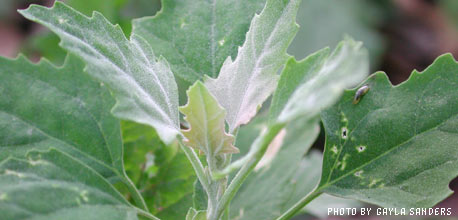 Guest post by Niki Jabbour
Guest post by Niki Jabbour
Weeding is one of my least favourite activities and in terms of fun I would have to rate it somewhere between getting a root canal and beating my head repeatedly against a wall. That said, there is a certain amount of satisfaction derived from yanking on a dandelion and having the entire root slip easily from the soil.
After a rain I can often be found gleefully ripping weeds from the still damp soil of the perennial gardens. The ease with which the long taproots slip from the moist soil is a heady delight. When I’ve managed to pluck a particularly large weed in its entirety, I exuberantly wave it in the air to show my husband what a prize I’ve captured. He nods patiently knowing that I’m well on my way to complete insanity.
Weeding is a necessary evil in order to promote healthy plant growth and keep a garden looking its best. We all have certain weeds that we struggle with continuously year after year and my nemeses include Queen Anne’s lace and clover, although wild mustard is steadily climbing up the list. Corn Spurry plagues the veggie garden and if left to its own devices soon runs rampant choking out the precious cucumbers and tomatoes.
Since the definition of a weed is “any unwanted plant,” I can easily categorize my very unwanted patch of curly mint as a weed. I did know better than to plant it near the perennials, so I have no idea what I was thinking the day I nestled the harmless springs of mint beneath the vigorous leaves of my beloved delphiniums.
Although this particular garden was a contained raised bed, heavily lined with three layers of landscape fabric, two short years later the mint had spread not only across, but far beyond the containment of the garden assaulting the lawn, the gravel path meandering between the garden beds and into the distant rose garden. I comfort myself with the fact that if nothing else, the mint smells incredible when trod upon by wandering feet.
Not only do weeds make our gardens appear untidy, they also compete with our treasured plants for moisture, light and nutrients. As well, many weed species shelter insects and diseases, therefore eliminating weeds can increase the general health of your garden!
Have you ever noticed that when a weed is pulled from the garden, it seems as if two more grow in its place? Most weeds are not only extremely hardy and competitive, but they also produce profuse amounts of seed that sprout up year after year. As weed seeds may remain dormant in the soil for several seasons before germinating, it is therefore vital to eliminate weeds before they are allowed to produce seeds.
Mulch is a great weed suppressor and is readily available from most garden centers in the form of wood chips, shredded bark, pea gravel or chopped leaves. Applied after weed removal (sorry, not before!), mulch will create a clean, attractive appearance and help repel encroaching weeds from your garden beds. It will also suppress further weed seed germination by blocking light from the soil.
A layer of mulch that is 2″ to 3″ is usually sufficient to suppress weed growth, but if you have particularly persistent weeds a 4″ thick layer may be required. Ensure that the mulch does not come in direct contact with the stems or trunks of the plants as slugs, moles and other small creatures that snack on plants may hide there.
Weeds in your grass can be a nuisance if you long for a putting-green perfect lawn. The key to minimizing weeds is to keep your grass healthy and to practice proper mowing techniques. Proper mowing practices include ensuring that your lawn mower blade is sharpened several times a season to prevent damage to delicate grass blades and putting the blade on its highest setting.
Grass that is kept at least 3″ high will be healthier than a short mowed lawn as taller grass will help shade out the ground, preventing weed seed germination. Taller grass will also hold more moisture, helping to prevent drought damage and encouraging your lawn to produce deep vigorous roots. Finally, be sure to leave the grass clippings on the lawn after each mowing to break down and restore nitrogen to the soil.
The best defense against persistent weeds in the garden or in the lawn is to keep your plants and grass healthy. Healthy plants will be able to outcompete weeds easier than those that have been weakened by drought, damage or disease! Be vigilant in the war against weeds by spending a few minutes each week removing any newly sprouted offenders. This will save you much future time and frustration and most importantly, your garden will thank you for it!
Niki Jabbour is an Ornamental Horticulturist and a writer from Halifax, Nova Scotia. Fertilized by sea breezes, her gardens are comprised of a colourful mixture of perennials, annuals, vegetables, herbs and flowering shrubs, with a few patches of clover and chickweed thrown in for good measure. A member of the Garden Writers Association of America, Niki is also the weekly gardening columnist for the Halifax Daily News and the Chester Clipper.